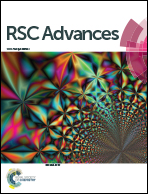Fabrication of high-k epoxy composites with low dielectric loss based on polymer shell-coated multiwalled carbon nanotubes†
Abstract
A core–shell microstructured hybrid was controllably synthesized by coating cross-linked polymer shell onto multiwalled carbon nanotubes (MWCNTs) via direct in situ free-radical polymerization, and was compounded with epoxy to solve the conundrum of percolative composites, namely large dielectric loss caused by direct contact between conductive fillers near the percolation threshold. The shell thickness of the prepared polymer-coated MWCNTs could be varied from 10 to 60 nm by controlling the weight ratio of the monomers. Because the insulative polymer shells serve as electrical barriers between the MWCNTs cores to form a continuous MWCNT-barrier network, the direct contact between the conductive fillers in the composites near the percolation threshold, that is to say the high leakage currents, can be effectively relieved. When the content of the coated MWCNTs reached 10 wt%, the dielectric properties of the composites achieved a dielectric constant value as high as 173.3 and a dielectric loss value as low as 0.021 at 105 Hz. The effect of the thickness of the coating layer on the dielectric properties of the composites was also investigated. This simple method of coating MWCNTs is expected to be applied to materials with a high dielectric constant and low dielectric loss in the field of microelectronics.


 Please wait while we load your content...
Please wait while we load your content...